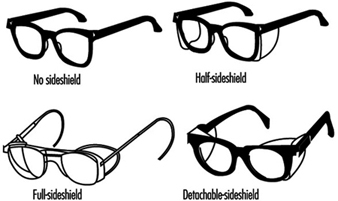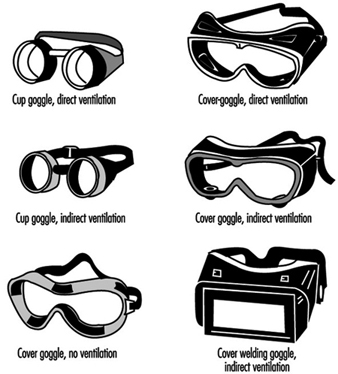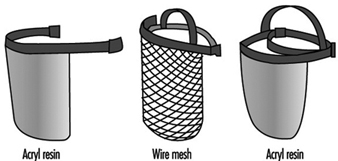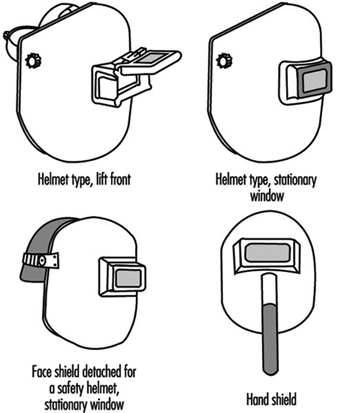Eye and face protection includes safety spectacles, goggles, face shields and similar items used to protect against flying particles and foreign bodies, corrosive chemicals, fumes, lasers and radiation. Often, the whole face may need protection against radiation or mechanical, thermal or chemical hazards. Sometimes a face shield may be adequate also for protecting the eyes, but often specific eye protection is necessary, either separately or as a complement to the face protection.
A wide range of occupations require eye and face protectors: hazards include flying particles, fumes or corrosive solids, liquids or vapours in polishing, grinding, cutting, blasting, crushing, galvanizing or various chemical operations; against intensive light as in laser operations; and against ultraviolet or infrared radiation in welding or furnace operations. Of the many types of eye and face protection available, there is a correct type for each hazard. Whole-face protection is preferred for certain severe risks. As needed, hood or helmet type face protectors and face shields are used. Spectacles or goggles may be used for specific eye protection.
The two basic problems in wearing eye and face protectors are (1) how to provide effective protection which is acceptable for wearing over long hours of work without undue discomfort, and (2) the unpopularity of eye and face protection due to restriction of vision. The wearer’s peripheral vision is limited by the side frames; the nose bridge may disturb binocular vision; and misting is a constant problem. Particularly in hot climates or in hot work, additional coverings of the face may become intolerable and may be discarded. Short-term, intermittent operations also create problems as workers may be forgetful and disinclined to use protection. First consideration should always be given to the improvement of the working environment rather than to the possible need for personal protection. Before or in conjunction with the use of eye and face protection, consideration must be given to guarding of machines and tools (including interlocking guards), removal of fumes and dust by exhaust ventilation, screening of sources of heat or radiation, and screening of points from which particles may be ejected, such as abrasive grinders or lathes. When the eyes and face can be protected by the use of transparent screens or partitions of appropriate size and quality, for example, these alternatives are to be preferred to the use of personal eye protection.
There are six basic types of eye and face protection:
- spectacle type, either with or without side shields (figure 1)
- eye cup (goggle) type (figure 2)
- face shield type, covering eye sockets and the central portion of the face (figure 3)
- helmet type with shielding of the whole front of the face (figure 4)
- hand-held shield type (see figure 4)
- hood type, including the diver’s helmet type covering the head completely (see figure 4)
Figure 1. Common types of spectacles for eye protection with or without sideshield
Figure 2. Examples of goggle-type eye protectors
Figure 3. Face shield type protectors for hot work
Figure 4. Protectors for welders
There are goggles that may be worn over corrective spectacles. It is often better for the hardened lenses of such goggles to be fitted under the guidance of an ophthalmic specialist.
Protection against Specific Hazards
Traumatic and chemical injuries. Face shields or eye protectors are used against flying
particles, fumes, dust and chemical hazards. Common types are spectacles (often with side shields), goggles, plastic eye shields and face shields. The helmet type is used when injury risks are expected from various directions. The hood type and the diver’s helmet type are used in sand- and shot-blasting. Transparent plastics of various sorts, hardened glass or a wire screen may be used for protection against certain foreign bodies. Eye cup goggles with plastic or glass lenses or plastic eye shields as well as a diver’s helmet type shield or face shields made of plastic are used for protection against chemicals.
Materials commonly used include polycarbonates, acrylic resins or fibre-based plastics. Polycarbonates are effective against impacts but may not be suitable against corrosives. Acrylic protectors are weaker against impacts but suitable for protection from chemical hazards. Fibre-based plastics have the advantage of adding anti-misting coating. This anti-misting coating also prevents electrostatic effects. Thus such plastic protectors may be used not only in physically light work or chemical handling but also in modern clean-room work.
Thermal radiation. Face shields or eye protectors against infrared radiation are used mainly in furnace operations and other hot work involving exposure to high-temperature radiation sources. Protection is usually necessary at the same time against sparks or flying hot objects. Face protectors of the helmet type and the face shield type are mainly used. Various materials are used, including metal wire meshes, punched aluminium plates or similar metal plates, aluminized plastic shields or plastic shields with gold layer coatings. A face shield made of wire mesh can reduce thermal radiation by 30 to 50%. Aluminized plastic shields give good protection from radiant heat. Some examples of face shields against thermal radiation are given in figure 1.
Welding. Goggles, helmets or shields that give maximum eye protection for each welding and cutting process should be worn by operators, welders and their helpers. Effective protection is needed not only against intensive light and radiation but also against impacts upon the face, head and neck. Fibreglass-reinforced plastic or nylon protectors are effective but rather expensive. Vulcanized fibres are commonly used as shield material. As shown in figure 4, both helmet type protectors and hand-held shields are used to protect the eyes and face at the same time. Requirements for correct filter lenses to be used in various welding and cutting operations are described below.
Wide spectral bands. Welding and cutting processes or furnaces emit radiations in the ultraviolet, visible and infrared bands of the spectrum, which are all able to produce harmful effects upon the eyes. Spectacle type or goggle type protectors similar to those shown in figure 1 and figure 2 as well as welders’ protectors such as those shown in figure 4 can be used. In welding operations, helmet type protection and hand-shield type protectors are generally used, sometimes in conjunction with spectacles or goggles. It should be noted that protection is necessary also for the welder’s assistant.
Transmittance and tolerances in transmittance of various shades of filter lenses and filter plates of eye protection against high-intensity light are shown in table 1. Guides for selecting correct filter lenses in terms of the scales of protection are given in table 2 through table 6).
Table 1. Transmittance requirements (ISO 4850-1979)
|
Scale number |
Maximum transmittance in the ultraviolet spectrum t ( |
Luminous transmittance ( |
Maximum mean transmittance in the infrared spectrum , % |
|||
|
|
313 nm |
365 nm |
maximum |
minimum |
Near IR 1,300 to 780 nm, |
Mid. IR 2,000 to 1,300 nm , |
|
1.2 1.4 1.7 2.0 2.5 3 4 5 6 7 8 9 10 11 12 13 14 15 16 |
0,0003 0,0003 0,0003 0,0003 0,0003 0,0003 0,0003 0,0003 0,0003 0,0003 0,0003 0,0003 0,0003 Value less than or equal to transmittance permitted for 365 nm |
50 35 22 14 6,4 2,8 0,95 0,30 0,10 0,037 0,013 0,0045 0,0016 0,00060 0,00020 0,000076 0,000027 0,0000094 0,0000034 |
100 74,4 58,1 43,2 29,1 17,8 8,5 3,2 1,2 0,44 0,16 0,061 0,023 0,0085 0,0032 0,0012 0,00044 0,00016 0,000061 |
74,4 58,1 43,2 29,1 17,8 8,5 3,2 1,2 0,44 0,16 0,061 0,023 0,0085 0,0032 0,0012 0,00044 0,00016 0,000061 0,000029 |
37 33 26 21 15 12 6,4 3,2 1,7 0,81 0,43 0,20 0,10 0,050 0,027 0,014 0,007 0,003 0,003 |
37 33 26 13 9,6 8,5 5,4 3,2 1,9 1,2 0,68 0,39 0,25 0,15 0,096 0,060 0,04 0,02 0,02 |
Taken from ISO 4850:1979 and reproduced with the permission of the International Organization for Standardization (ISO). These standards can be obtained from any ISO member or from the ISO Central Secretariat, Case postale 56, 1211 Geneva 20, Switzerland. Copyright remains with ISO.
Table 2. Scales of protection to be used for gas-welding and braze-welding
|
Work to be carried out1 |
l = flow rate of acetylene, in litres per hour |
|||
|
l £ 70 |
70 l £ 200 |
200 l £ 800 |
l > 800 |
|
|
Welding and braze-welding |
4 |
5 |
6 |
7 |
|
Welding with emittive |
4a |
5a |
6a |
7a |
1 According to the conditions of use, the next greater or the next smaller scale can be used.
Taken from ISO 4850:1979 and reproduced with the permission of the International Organization for Standardization (ISO). These standards can be obtained from any ISO member or from the ISO Central Secretariat, Case postale 56, 1211 Geneva 20, Switzerland. Copyright remains with ISO.
Table 3. Scales of protection to be used for oxygen cutting
|
Work to be carried out1 |
Flow rate of oxygen, in litres per hour |
||
|
900 to 2,000 |
2,000 to 4,000 |
4,000 to 8,000 |
|
|
Oxygen cutting |
5 |
6 |
7 |
1 According to the conditions of use, the next greater or the next smaller scale can be used.
NOTE: 900 to 2,000 and 2,000 to 8,000 litres of oxygen per hour, correspond fairly closely to the use of cutting nozzles diameters of 1 to 1.5 and 2 mm respectively.
Taken from ISO 4850:1979 and reproduced with the permission of the International Organization for Standardization (ISO). These standards can be obtained from any ISO member or from the ISO Central Secretariat, Case postale 56, 1211 Geneva 20, Switzerland. Copyright remains with ISO.
Table 4. Scales of protection to be used for plasma arc cutting
|
Work to be carried out1 |
l = Current, in amperes |
||
|
l £ 150 |
150 l £ 250 |
250 l £ 400 |
|
|
Thermal cutting |
11 |
12 |
13 |
1 According to the conditions of use, the next greater or the next smaller scale can be used.
Taken from ISO 4850:1979 and reproduced with the permission of the International Organization for Standardization (ISO). These standards can be obtained from any ISO member or from the ISO Central Secretariat, Case postale 56, 1211 Geneva 20, Switzerland. Copyright remains with ISO.
Table 5. Scales of protection to be used for electric arc welding or gouging

1 According to the conditions of use, the next greater or the next smaller scale can be used.
2 The expression “heavy metals” applies to steels, alloy stells, copper and its alloys, etc.
NOTE: The coloured areas correspond to the ranges where the welding operations are not usually used in the current practice of manual welding.
Taken from ISO 4850:1979 and reproduced with the permission of the International Organization for Standardization (ISO). These standards can be obtained from any ISO member or from the ISO Central Secretariat, Case postale 56, 1211 Geneva 20, Switzerland. Copyright remains with ISO.
Table 6. Scales of protection to be used for plasma direct arc welding

1 According to the conditions of use, the next greater or the next smaller scale can be used.
The coloured areas correspond to the ranges where the welding operations are not usually used in the current practice of manual welding.
Taken from ISO 4850:1979 and reproduced with the permission of the International Organization for Standardization (ISO). These standards can be obtained from any ISO member or from the ISO Central Secretariat, Case postale 56, 1211 Geneva 20, Switzerland. Copyright remains with ISO.
A new development is the use of filter plates made of welded crystal surfaces which increase their protective shade as soon as the welding arc starts. The time for this nearly instantaneous shade increase can be as short as 0.1 ms. The good visibility through the plates in non-welding situations can encourage their use.
Laser beams. No one type of filter offers protection from all laser wavelengths. Different kinds of lasers vary in wavelength, and there are lasers that produce beams of various wavelengths or those whose beams change their wavelengths by passing through optical systems. Consequently, laser-using firms should not depend solely on laser protectors to protect an employee’s eyes from laser burns. Nevertheless, laser operators do frequently need eye protection. Both spectacles and goggles are available; they have shapes similar to those shown in figure 1 and figure 2. Each kind of eyewear has maximum attenuation at a specific laser wavelength. Protection falls off rapidly at other wavelengths. It is essential to select the correct eyewear appropriate for the kind of laser, its wavelength and optical density. The eyewear is to provide protection from reflections and scattered lights and the utmost precautions are necessary to foresee and avoid harmful radiation exposure.
With the use of eye and face protectors, due attention must be paid to greater comfort and efficiency. It is important that the protectors be fitted and adjusted by a person who has received some training in this task. Each worker should have the exclusive use of his or her own protector, while communal provision for cleaning and demisting may well be made in larger works. Comfort is particularly important in helmet and hood type protectors as they may become almost intolerably hot during use. Air lines can be fitted to prevent this. Where the risks of the work process allow, some personal choice among different types of protection is psychologically desirable.
The protectors should be examined regularly to ensure that they are in good condition. Care should be taken that they give adequate protection at all times even with the use of corrective vision devices.




